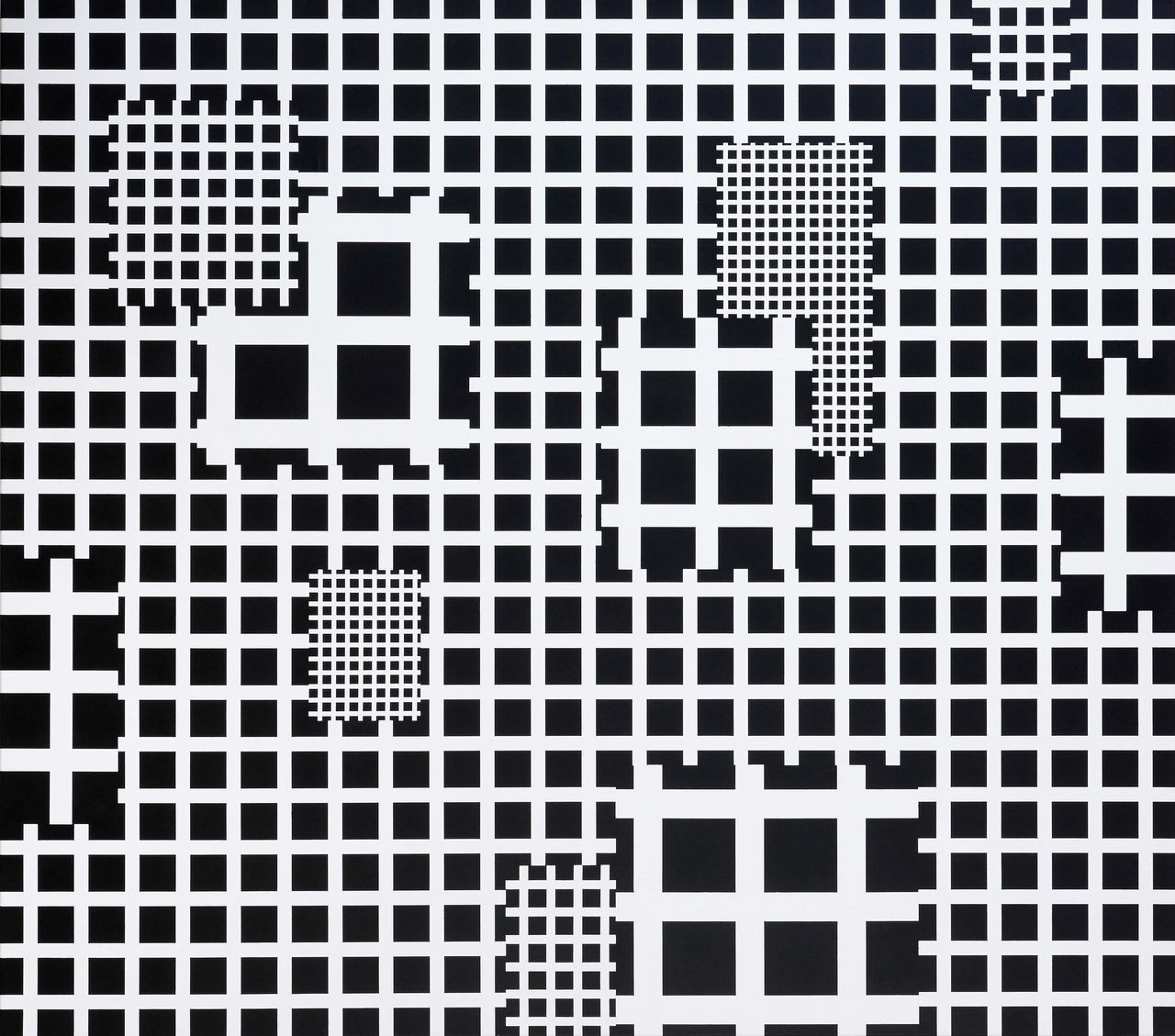Esther Stocker
09 Mar - 20 Apr 2016

Esther Stocker: Ohne Titel / Untitled, 2016
Acrylic on canvas, 140 x 160 cm, Unique
Photography: Meinrad Hofer
Acrylic on canvas, 140 x 160 cm, Unique
Photography: Meinrad Hofer
ESTHER STOCKER
09 March – 20 April 2016
Esther Stocker’s modernist form language manifests itself in a variety of artistic media, addressing a theme that dates back to the abstraction of painting in the early 20th century, when Kasimir Malevich’s Black Square on White (1915) transferred painting to the non-representational realm and introduced a spatial dimension. The departure of painting towards a three-dimensional approach that goes beyond figurative representation created a wider range of possibilities to view art as a holistic experience of philosophical issues.
In her works, Stocker uses diverse media to address the resumption of a Malevichian discourse on abstraction geared to the theory of space. The artist systematically checks the validity of the two-dimensional logic of imagination in painting and breaks up its spatial limitations. By using black-and-white patterns and textures, she releases the viewer from the perception of colour and draws their attention directly to spatial structures. Stocker’s artistic work deals with the juxtaposition of painting, photography and sculpture as an interaction between theories that encompass all spatial dimensions.
(Excerpt from: Walter Seidl about Esther Stocker, Krobath Wien, 2013)
The interest in precisely analyzing scientifically a specific subject or area seems to be tied to an inescapable paradox: the more exactly and exhaustively that one examines a specific interest, the more expectations are frustrated, allowing exceptions to the rule to come to light. This makes it clear what methodological approaches truly are: assumptions that require examination and correction, and, moreover, assumptions linked ideologically to their subjects of investigation — not merely externally, but instead from the very outset. In order to sharpen itself, precision seems condemned to constantly relativize its claims to infallibility. For this reason, the meaning of precision, order, and systematicity are dependent, not least of all, upon the deviations, irritations, and adaptations resulting from their use.
The thesis that such mechanisms also operate in the art realm by shaping research into its own order will be outlined in this essay by referring to the works of Esther Stocker. The paintings, murals and installations of Stocker, based on grid structures and on the colors black, white, and gray, consistently manifest entanglements, interconnections, interpenetrations, both semantically and formally, for which the variably deployed grid motif functions as a metaphorical logo. Stocker consistently breaks with one-dimensional notions of order, space, and painting, while also posing the question of the possibility and the significance of order, space, and painting as contextual and relational factors and concepts. When an artist so persistently preoccupied with spatial structures and spatial experience, simultaneously calls attention to the fact that “we know nothing about space” (Stocker), then her stance would seem to testify to a productive skepticism which arises from unremitting and methodical attempts at understanding, and from insight into their — in principle — interminability.
(Excerpt from: Rainer Fuchs "Systematically Broken Systems" Text und Kritik 2008)
09 March – 20 April 2016
Esther Stocker’s modernist form language manifests itself in a variety of artistic media, addressing a theme that dates back to the abstraction of painting in the early 20th century, when Kasimir Malevich’s Black Square on White (1915) transferred painting to the non-representational realm and introduced a spatial dimension. The departure of painting towards a three-dimensional approach that goes beyond figurative representation created a wider range of possibilities to view art as a holistic experience of philosophical issues.
In her works, Stocker uses diverse media to address the resumption of a Malevichian discourse on abstraction geared to the theory of space. The artist systematically checks the validity of the two-dimensional logic of imagination in painting and breaks up its spatial limitations. By using black-and-white patterns and textures, she releases the viewer from the perception of colour and draws their attention directly to spatial structures. Stocker’s artistic work deals with the juxtaposition of painting, photography and sculpture as an interaction between theories that encompass all spatial dimensions.
(Excerpt from: Walter Seidl about Esther Stocker, Krobath Wien, 2013)
The interest in precisely analyzing scientifically a specific subject or area seems to be tied to an inescapable paradox: the more exactly and exhaustively that one examines a specific interest, the more expectations are frustrated, allowing exceptions to the rule to come to light. This makes it clear what methodological approaches truly are: assumptions that require examination and correction, and, moreover, assumptions linked ideologically to their subjects of investigation — not merely externally, but instead from the very outset. In order to sharpen itself, precision seems condemned to constantly relativize its claims to infallibility. For this reason, the meaning of precision, order, and systematicity are dependent, not least of all, upon the deviations, irritations, and adaptations resulting from their use.
The thesis that such mechanisms also operate in the art realm by shaping research into its own order will be outlined in this essay by referring to the works of Esther Stocker. The paintings, murals and installations of Stocker, based on grid structures and on the colors black, white, and gray, consistently manifest entanglements, interconnections, interpenetrations, both semantically and formally, for which the variably deployed grid motif functions as a metaphorical logo. Stocker consistently breaks with one-dimensional notions of order, space, and painting, while also posing the question of the possibility and the significance of order, space, and painting as contextual and relational factors and concepts. When an artist so persistently preoccupied with spatial structures and spatial experience, simultaneously calls attention to the fact that “we know nothing about space” (Stocker), then her stance would seem to testify to a productive skepticism which arises from unremitting and methodical attempts at understanding, and from insight into their — in principle — interminability.
(Excerpt from: Rainer Fuchs "Systematically Broken Systems" Text und Kritik 2008)
